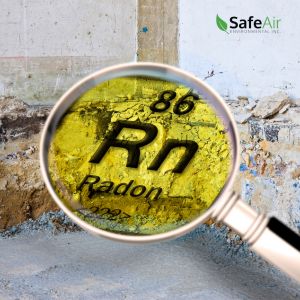The Link Between Radon and Negative Health Effects
Posted in Radon Testing, on March 22, 2024
Long-term exposure to chemicals and pollutants is a well-documented cause of severe chronic illness. At SafeAir, we help folks uncover the kinds of substances that may be present in their homes with processes like radon testing. Radon gas is one of the most common undetected indoor air quality pollutants in the GTA, and it’s often overlooked in regular home air quality testing because of the need to test over a long period of time. Today’s blog will examine the links between radon and adverse health outcomes and how SafeAir can help.
 A Quick Lesson on Radon
A Quick Lesson on Radon
We write about radon a lot here at SafeAir because we believe it to be one of the most dangerous hidden air quality problems in Ontario homes. Radon is invisible, scentless, and makes no physical mark or sound. It forms deep in the earth’s crust, so it’s impossible to tell if your home sits on top of it, and it can sneak in through the tiniest cracks of your home’s foundation — even through your well water! Because you can’t sense it without help, SafeAir recommends that everyone test their home to ensure they are not affected.
The Effect Radon Has on Your Health
Radon is a radioactive particle, and while targeted radiation has wonderful uses in medicine, the type of exposure and makeup of radon gas renders it highly dangerous to human health. When you are exposed to radon gas, the tiny particles enter your respiratory system and end up lodged throughout your throat and lungs. As they decompose, they burst — causing inflammation and damage to delicate cells. Over time, this damage causes the kind of changes that lead to lung cancer. In Canada, radon is the second-most leading cause of lung cancer after cigarette smoking, making it a grave health concern.
Discovering Radon in Your Home
As we mentioned earlier, radon gas usually enters homes in the basement or lower levels, where it gains access through cracks in the foundation, sump pumps, poorly sealed windows or doors, and other small gaps or cracks. Having sub-grade rooms tends to draw radon gas from the surrounding soil into your home because of negative pressure. Once drawn in, radon gas often has no way to escape, building up to toxic levels.
The good news is that radon particles are easy to detect. During a short visit, we carefully install the testing device in the lower level of your home and then leave it to work passively for 3-6 months. This long-term testing is essential for accurate results that even out shifts caused by weather or temperature changes. After the testing period, we send it to the lab for analysis.
Safer Air, Healthier Lifestyle
Clean air is more than a fresh scent; it encompasses chemicals, particles like radon, pollutants, allergens, and more! Home air quality testing can determine your home’s unique air environment and help you make changes to eliminate dangerous long-term health problems. To learn more about radon testing or environmental assessments, contact the SafeAir team today.

